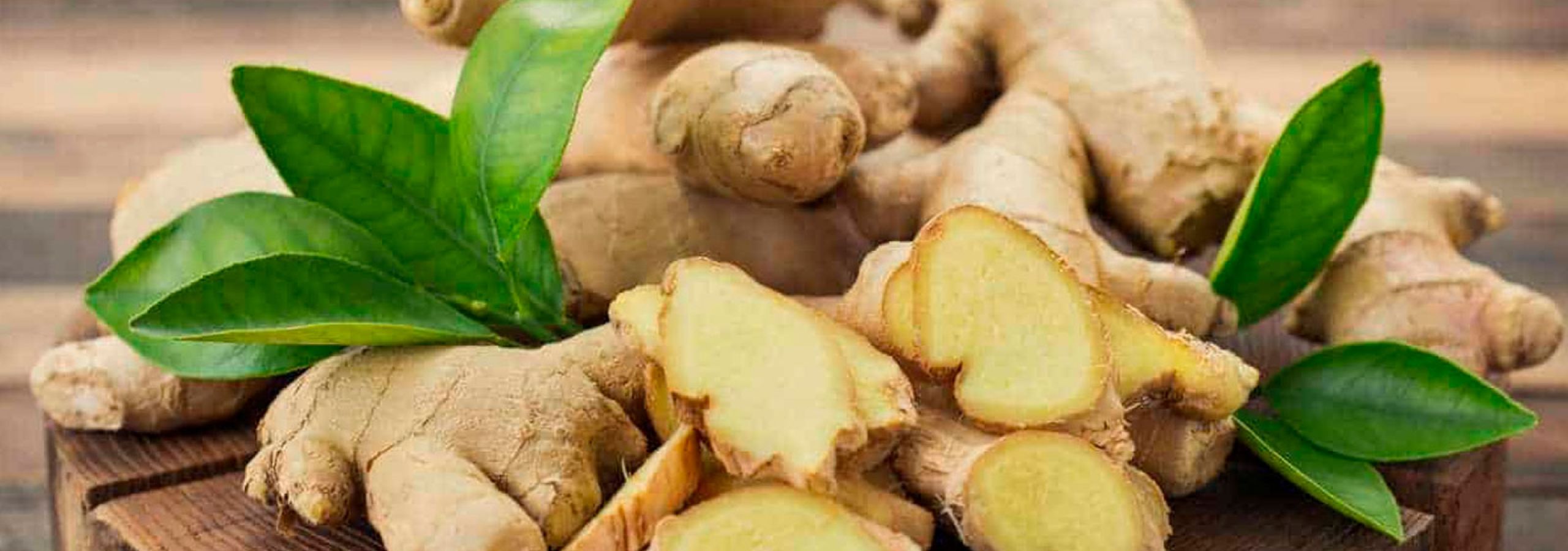
Ginger
We’re all familiar with ginger, but what we may not know is the part one consumes from this indigenous Indian plant is not a root, but a rhizome or underground section of the stem. The plant reaches 90 cm in height, with leaves 20 cm big and a 3 to 20 cm rhizome. Ginger is greatly appreciated because of its citric scent and spicy flavor. It arrived in Europe since the time of the ancient Greeks, who spread its medicinal and culinary use.
Ginger is so popular in India it goes by two names: “ardra” when it’s fresh and “shunthi” when it’s dried. Ayurveda recognizes its antidiuretic, analgesic and calorific properties, with specific impact in the respiratory and digestive systems, which is why it’s recommended for consumption on a daily basis, except on very hot days. Ginger cures vata and kapha disorders, mildly increases pitta for its taste (rasa) is spicy and its property (virya) is hot.
Medicinal juice
One of the most used tonics by Ayurveda therapists is the ginger medicinal juice. The simplest way to prepare it is to macerate fresh ginger and filter it through a cotton cloth. Sugar or honey may be added and it will harmonize the respiratory ways in case of pharyngitis, laryngitis and bronchitis. It also eliminates gases, is an appetite stimulant (specially in children) it helps expectoration. People of all ages and constitutions can consume this concoction without having any side effects. It also tones up the digestive fire (agni) which diminishes with age and stress, allowing for a better digestion and metabolism of food. It’s used to treat rheumatism, cough, indigestion and lack of appetite. It stimulates de assimilation of food and eliminates gases as well. It combats leucorrhea (whitened vaginal secretion) and its recommended for treating cases of colitis and lumbago.
Properties
It helps with indigestion: it stimulates the liver’s function, eliminates harmful intestinal bacteria, betters the intestinal flora and prevents abdominal swelling and gas.
Circulatory tonic: it induces blood flow towards the periphery, which allows the alleviation of chilblains (inflammation caused by intense cold), hypertension and fever; it inhibits platelet aggregation which is why it prevents cardiovascular illnesses.
Antioxidant: it delays the aging process.
Anti-inflammatory: this property is thanks to the gingerols (its main active components). It alleviates pain, swelling and betters the mobility of those who suffer from rheumatic arthritis.
Anticancer: colonic cancer cell growth is inhibited by the gingerols.
Muscular activity: due to its high content of magnesium, manganese, calcium and phosphor, which are minerals that intervene in the contraction of muscles and the transmission of nerve impulses, it prevents weakness and muscular spasms.
Antiseptic: it fights off throat infections.
Caloric: it helps with sweating; useful in colds and fever.
Combats dizziness and nausea: it reduces vertigo and it’s useful for pregnancy nausea.
Combats bad breath: just chew on a small piece of fresh or pickled ginger after every meal.
¿Why does it have these properties? Ginger contains considerable quantities niacin (vitamin B3), vitamin B6, potassium, zinc and even more so: iron, magnesium and manganese. It’s rich in volatile oils, phenolic substances (gingerols, shoagols and gingerones) as well as in proteolic enzimes and linoleic acid.
Although there aren’t any proper contraindications when consumed, it can cause gastritis in high doses and it’s not recommended for persons suffering from a gastroduodenal ulcer. Pregnant and lactating women should only take low doses and for short periods. It’s also not recommended for children under six.
In the kitchen
In India, ginger aromatizes dishes prepared with rice, chutney (bittersweet sauces), desserts, as well as hot and cold drinks. It can be added to black tea or coffee. It also enrichens food of sweet or delicate taste, like rice, fruits and vegetables.
In the west, wine, ginger ale, cookies, bread and crystalized fruit are made with ginger. Because of its spicy and citric taste, it mixes well with soy sauce, vinegar, lime and lemon juice, sesame, oil, miso, and it’s used in the elaboration of sauces, vinaigrette and condiments.
The experts agree that the secret with ginger is to get it fresh and without wrinkles. It can be frozen for conservation after peeling or grating it.



